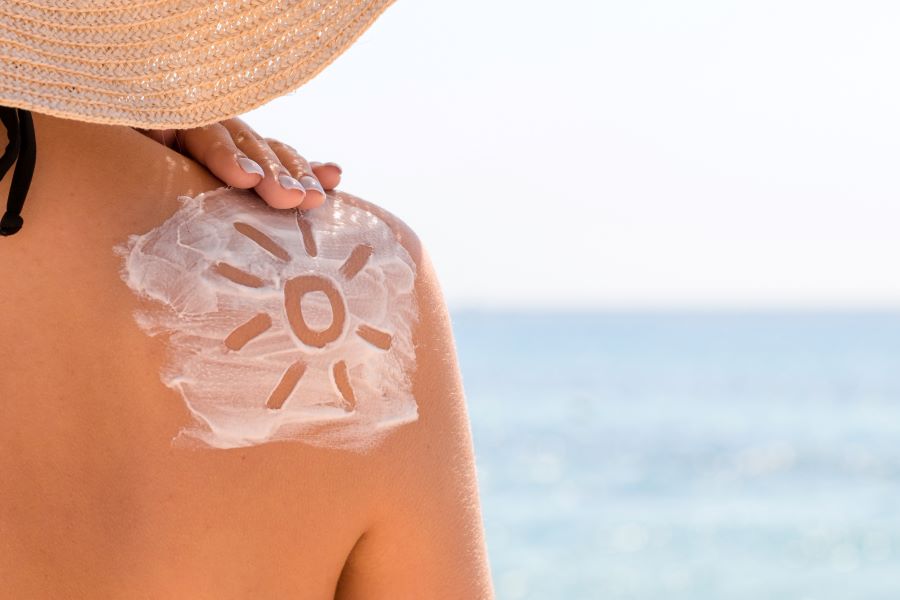Hey everyone, I’m Dr Ann, and today, I want to introduce you to someone. It protects you while sticking by your side, closer to you than your shadow- Sunscreen. Please take a closer look at it. You will be surprised by its magical work on your skin all year round.
- Age Limit for Sunscreen: There is an age limit for Sunscreen, for babies under 6 months, use protective clothing and shade and sunscreens are not usually licensed. Consider mineral-based sprays if necessary. For older kids, choose child-friendly, water-resistant Sunscreen with high SPF and UVA ratings. Reapply every 2 hours.
- SPF Makeup: SPF makeup alone isn’t sufficient for face protection. Sunscreen should be a central part of your daily skincare routine.
- Additional Protection: Protect your eyes and lips with SPF balms, sunscreen sticks, sunglasses, and hats.
- Sunscreen Expiry: Sunscreen does expire. Unopened ones can usually last up to 3 years, but opened can stop working [ check instructions] Store it in a cool place or wrap the bottle in a towel to keep it fresh.
- Combining Repellent and Sunscreen: Combining insect repellent with Sunscreen can reduce its effectiveness, mainly if it contains DEET. Consider DEET-free options or reapply Sunscreen more frequently when using DEET-based repellents. [check instructions]
- Skin Lightening: Sunscreen doesn’t lighten your skin. It’s meant to protect your skin from sun damage and uneven pigmentation.
- Preventing Tanning: Sunscreen can prevent tanning if used correctly. A tan can signal exposure and overexposure can have potential risks like sunburn and skin cancer. Love your natural skin tone.
- Next-Level Protection: Consider sun-protective clothing with a UPF above 40. Denim, merino wool, and tight weaves offer good protection. Dark shades are often more effective.
Conclusion
It’s important to remember that while Sunscreen is a powerful tool, it doesn’t offer absolute protection. To shield your skin effectively, combine Sunscreen with other precautions like wearing hats, sunglasses, protective clothing, and seeking shade during the sun’s peak hours.
Did you know that the sun’s rays have a knack for finding you out even during overcast days? If not directly, then indirectly, though, as the sun’s rays reflect off surfaces of snow, water, and even cement. Hence, Sunscreen for your skin. Why?
To stay shielded. Hence, apply Sunscreen regularly. It will also help you shield your skin from painful sunburn. In the process, your Sunscreen transforms itself as a knight in shining armour against skin cancer—a concern for everyone, regardless of age, race, or gender. Bonus? It can quickly become your beauty routine BFF, a.k.a. your anti-ageing secret weapon.
How often should you apply it? Is there such a thing as too much Sunscreen? Before you start using and possibly panicking, let’s start with the basics of keeping your skin happy!
Which Sunscreen is best
Explore the best Sunscreen choices best tailored for you
Perhaps you have an upcoming exotic vacation. Sunscreens are obviously on your bucket list. So, you head to the nearest pharmacy. Once inside, your eyes meet lots of options in the sunscreen aisle. Your mind fails to process, or should I call it, a frozen mind experience.
Avoid getting bulldozed by options. Look for labels that read: sensitive skin, fragrance-free, paraben-free, mineral base, and hypoallergenic.
Choose a Sunscreen for its ability to shield you from sun rays if you think your exposure to it will be more.
Types of sun rays
- UVB Rays – They contribute to sunburn and many skin cancers. 95% of the sun’s rays are UVB.
- UVA Rays – Though not immediate, they are responsible for long-term skin changes, like wrinkles. They can also play a role in some skin cancers.
- 3. UVC rays
The term’ broad spectrum’ ensures the protection against UVB and UVA rays.
What does the SPF number mean on Sunscreen?
While studying the SPF rating, look out for a broad spectrum to ensure protection against both types of UV rays – UVB and UVA. The SPF number is protection against UVB.
The SPF label on any Sunscreen will vary with numbers from 2 to a whopping 50+. These numbers will help determine how long you can soak up the sun without glowing red like a tomato.
For instance, assume it would take 10 minutes for your skin to get a natural tan. Applying an SPF 15 sunscreen will take 15 times longer for the sun to affect your skin, which is 150 minutes.
Sunscreen is a powerful ally for your skin, but not 100% effective against sun rays. So, tread out in the sun with a bit of caution.
SPF 15 usually shields you from around 94% UVBs,
SPF 30 boosts that to 97%,
SPF 50+? An astonishing 98%.
- SPF Magic Number
The golden rule from the experts? Aim for SPF 30 or above.
Top tips to determine the best SPF for you
- Picking the perfect SPF isn’t one-size-fits-all. Mid-day sun is fiercer than early morning or late afternoon rays. Suppose you’re vacationing closer to the equator. Pack in more Sunscreens for added protection. Take advantage of outdoor fun – festivals, family barbecues, beach days and so on.
- Plus, the fairer your skin (possibly paired with red hair), the more important to amp up your sunscreen game due to less melanin [less pigment] .Melanin helps protect the cells of the epidermis, or outer layer of the skin, from UV light. Your distinct hair, eye and skin pigmentation is because of Melanin, a substance in your body. People have darker eyes, hair and skin because their bodies produce more Melanin.
What is a UVA star?
The star rating measures the amount of ultraviolet A radiation (UVA) protection.
Protection ratings vary across the globe. For example, in the UK and Europe, the star game is strong, and you should aim for at least 4 out of 5. If you shop for Sunscreen in other countries, such as Japan, watch for the PA ratings, from PA+ to top-gun PA++++.
If unsure go for broad spectrum to get protection against both.
Chemical versus mineral sunscreen
While chemical Sunscreens effectively absorb harmful rays, they seem to have some ingredients which could be harmful to humans but further research is needed. So, there is ongoing research to validate the safety of some chemical sunscreen components.
If the FDA considers ingredients in a sunscreen as GRASE – Generally Recognized As Safe and Effective, then the product can be manufactured without going through an FDA approval process.
The FDA is calling for more data on the following 12 ingredients before determining whether these ingredients can continue to be classified as GRASE Ingredients commonly used in the U.S.: Ensulizole, octisalate, homosalate, octocrylene, octinoxate, oxybenzone, avobenzone.
- Ingredients not frequently used in the U.S.: Cinoxate, dioxybenzone, meradimate, padimate O, sulisobenzone.
FDA is seeking more data. But they do not rule that the ingredients are unsafe. So far, it has not asked the public to refrain from using sunscreens that contain any of these ingredients.
There was a study by the FDA recently. They examined four sunscreen ingredients and observed their absorption into the body. Their investigation concluded that there was a need for additional research. It was to determine if the absorption has any effects on a person’s health. The researchers viewed that just because your body absorbs an ingredient does not mean it is harmful or unsafe.
Common ingredients which are harmful to marine ecosystems include , oxybenzone and octinoxate-that, etc.
Mineral Sunscreens – minerals like zinc or titanium dioxide get cooled to form a literal shield on your skin. They primarily focus on the surface and aim to deflect UV. They are safe for humans and the environment.
As they are on the surface and create a barrier [ compared to chemicals which are absorbed] – they usually have fewer skin irritations or allergic reactions. Mineral Sunscreens don’t harm coral reefs either.
Both types offer a very efficient shield for your skin, mainly if you apply them 30 minutes before sun exposure. Depending on your skin type and care for the environment, you might lean one way over the other.
What is a water-resistant sunscreen?
Sunscreens, labelled water-resistant, protect your skin while swimming or sweating for a certain amount of time (usually 40 or 80 minutes). However, it’s crucial to reapply them as instructed, especially after swimming, sweating, or towel drying.
How to choose the right Sunscreen for your skin type?
- You can avail Sunscreens in many forms- gels to creams, sprays to sticks, and even foamy lotions.
- A breezy alcohol-based lotion or spray is best suited for oily skin.
- Dry skin pals might love a rich cream.
- Roll-ons? Perfect pocket companions!
- If you’re into water sports, gear up with water-resistant armour. But remember: swim, dry, reapply!
- Fun fact: you can buy tinted Sunscreen, which means there won’t be any white cast. No matter your skin tone, Sunscreen has got you covered!
How to test your Sunscreen?
Before diving into a new sunscreen:
- Please give it a mini-test.
- Dab a smidge on a tiny skin patch and wait 24-48 hours.
- Keep an eye out for any unwanted reactions.
Discuss with a dermatologist if you are not sure which you can use.
Is there a maximum effectiveness of Sunscreen? Follow my TOP TIPS.
Timing is Everything
Ideally, lather up about 30 minutes before stepping into the great outdoors. Also, make Sunscreen your AM best friend. Daily sun protection can fend off damage and signs of ageing.
Apply Sunscreen Generously
Think you’ve applied enough? Probably not! The average adult needs about 6 to 8 teaspoons (roughly 35ml) to cover up generously. Please give it a good rub and ensure you’ve got every inch! The ears, feet, and the top of the head are the classic “oops” zones. Sporting thin hair or a bald shine? Pop on a hat, or be extra diligent!
Reapplication – Stay Fresh & Protected
Revisiting your Sunscreen every 2 hours should be your mantra! Sweat, clothes, and time can diminish its power. Remember, “water-resistant” is helpful, but it’s not a forever promise. Even when you choose the “all-day” protection, play it safe by layering up often, especially on commonly missed spots.
References:
https://www.google.com/url?q=https://my.clevelandclinic.org/health/body/22615-melanin&sa=D&source=docs&ust=1699960748959227&usg=AOvVaw1OTJIrsIE72JbTDwl938Dw
Disclaimer: The Content on this channel is for educational purposes and not intended to be a substitute for professional medical advice, diagnosis, or treatment. Always get advice from your Doctor if you are worried or have symptoms.



3 Comment(s)
by Shelia
You really make it appear really easy together with your presentation however I
in finding this topic to be actually one thing which I think I
would never understand. It sort of feels too complex and
very broad for me. I’m looking ahead in your subsequent post,
I will attempt to get the hold of it!
by annnainan
thanks for reading 🙂